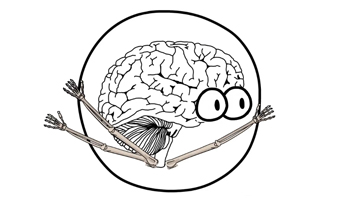Research studies show that improving the function of your spine can not only help your brain see what’s going on in your spine but can also help improve the way your brain can see what’s going on in your arms.
Improved visual acuity and visual field size are benefits of chiropractic care
Neck Pain
The research study revealed that patients with low level neck pain were given chiropractic adjustments. After this, they were better at re-positioning their arm. Their brains were better able to see where their arm was after they were adjusted by the chiropractor.
Video References
Now let’s take a look at a different study, this time exploring the brain’s ability to sense the position of the elbow when the arm is moved.1
The study involved 25 people with low level neck pain, and 18 healthy people with no pain at all. The healthy group was the control group.
All of the participants were tested for their brain’s ability to determine the exact position of their elbow joint. They were shown how to position their arm while lying down and then were asked to reproduce this angle with their eyes closed. A fancy tool called an electro-goniometer was used to ensure that the findings were very accurate.
The control group was very good at knowing exactly where their elbows were positioned and could consistently reproduce the elbow position but the group with low level neck pain were not so good at knowing where their arms were.
The group with low level neck pain was then given chiropractic adjustments. After this, they were better at re-positioning their arm. Their brains were better able to see where their arm was after they were adjusted by the chiropractor.
This study was really cool because it shows that improving the function of your spine can not only help your brain see what’s going on in your spine but can also help improve the way your brain can see what’s going on in your arms
There are many, many more research studies like these that demonstrate all sorts of benefits from receiving chiropractic care. Such as improved visual acuity and visual field size; reaction times; brain processing; joint position sense in your ankle; spinal function; muscle strength in your leg muscles; and prevention of muscle fatigue. 2-14
We’ll explore more of this research in future videos. In the meantime, make sure you get yourself checked by your chiropractor.
References
- Haavik H, Murphy B. Subclinical neck pain and the effects of cervical manipulation on elbow joint position sense. J Manipulative Physiol Ther 2011;34(2):88-97.
- Herzog W, Scheele D, Conway PJ. Electromyographic responses of back and limb muscles associated with spinal manipulative therapy. Spine (Phila Pa 1976) 1999;24(2):146-53.
- Kelly DD, Murphy BA, Backhouse DP. Use of a mental rotation reaction-time paradigm to measure the effects of upper cervical adjustments on cortical processing: a pilot study. Journal of Manipulative & Physiological Therapeutics 2000;23(4):246-51.
- Niazi, I.K., Türker, K.S., Flavel, S., Kinget, M., Duehr, J., Haavik,H. Changes in H-reflex and V-waves following spinal manipulation. Exp Brain Res 2015; 233, 1165–1173
- Haavik Taylor H, Murphy B. Cervical spine manipulation alters sensorimotor integration: A somatosensory evoked potential study. Clin Neurophysiol 2007;118(2):391-402.
- Haavik Taylor H, Murphy B. Transient modulation of intracortical inhibition following spinal manipulation. Chiropractic Journal of Australia 2007;37:106-16.
- Haavik Taylor H, Murphy B. Altered sensorimotor integration with cervical spine manipulation. Journal of Manipulative and Physiological Therapeutics 2008;31(2):115-26.
- Haavik Taylor H, Murphy B. Altered Central Integration of Dual Somatosensory Input Following Cervical Spine Manipulation. Journal of Manipulative & Physiological Therapeutics 2010;33 (3):178-88.
- Suter E, McMorland G, Herzog G, et al. Conservative lower back treatment reduces inhibition in knee-extensor muscles: a randomized controlled trial. JMPT 2000;23(2):76-80.
- Suter E, McMorland G, Herzog W, et al. Decrease in quadriceps inhibition after sacroiliac joint manipulation in patients with anterior knee pain. Journal of Manipulative & Physiological Therapeutics 1999;22(3):149-53.
- Increased cortical drive and altered net excitability of low-threshold motor unit levels to the lower limb following spinal manipulation. World Federation of Chiropractic’s 12th Biennial Congress; 2013.
- Haavik Taylor H, Murphy B. The effects of spinal manipulation on central integration of dual somatosensory input observed following motor training: A crossover study. Journal of Manipulative & Physiological Therapeutics 2010;33 (4):261-72.
- Haavik H, Murphy B. Subclinical neck pain and the effects of cervical manipulation on elbow joint position sense. Journal of Manipulative & Physiological Therapeutics 2011;34:88-97.
- Haavik H, Murphy B. The role of spinal manipulation in addressing disordered sensorimotor integration and altered motor control. Journal of Electromyography and Kinesiology 2012;22(5):768-76.

